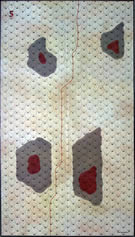|
Out of Gas DAK '44 #10 |
||
|---|---|---|
| (Attacker) Germany | vs |
Britain
(Defender)
New Zealand (Defender) |
| Formations Involved | ||
|---|---|---|
| Britain |  |
31st Field Regiment Royal Artillery |
| Germany |  |
5th Light Panzer Division |
| New Zealand |  |
23rd Infantry Battalion |
| New Zealand |  |
2nd Divisional Cavalry |

| Total | |
|---|---|
| Side 1 | 1 |
| Draw | 0 |
| Side 2 | 1 |
| Overall Rating, 2 votes |
|---|
|
4
|
| Scenario Rank: --- of 913 |
| Parent Game | DAK '44 |
|---|---|
| Historicity | Alt-History |
| Date | 1944-06-01 |
| Start Time | 12:00 |
| Turn Count | 20 |
| Visibility | Day |
| Counters | 95 |
| Net Morale | 0 |
| Net Initiative | 0 |
| Maps | 1: DR5 |
| Layout Dimensions | 88 x 58 cm 35 x 23 in |
| Play Bounty | 180 |
| AAR Bounty | 171 |
| Total Plays | 2 |
| Total AARs | 1 |
| Battle Types |
|---|
| Hill Control |
| Rural Assault |
| Conditions |
|---|
| Off-board Artillery |
| Terrain Mods |
| Scenario Requirements & Playability | |
|---|---|
| Cassino '44 | Counters |
| Desert Rats | Maps + Counters |
| DAK '44 | Base Game |
| Introduction |
|---|
|
While Libya would eventually become a major exporter of oil, none of those fields had been discovered in the 1940's. Instead, every drop of fuel had to be transported across the Mediterranean Sea in the teeth of fierce Allied air and naval opposition. By 1944, these fuel shortages could easily have been even more pronounced than in 1941 and 1942. |
| Conclusion |
|---|
|
Fuel supplies dominated Axis operational thinking during the North African campaigns, though units rarely actually ran out of gas on the battlefield - careful logistics planning made sure of that. But it was always a concern, as even the most powerful weapons would be useless without the fuel to move them. |
| AFV Rules Pertaining to this Scenario's Order of Battle |
|---|
|
| 4 Errata Items | |
|---|---|

|
The "Optional Values" for the 17-Pdr given in an Avalanche Press Daily Content piece on the 17-Pdr Anti-Tank gun (and printed on a replacement counter sheet Download) are now the Official Ratings, published in games like Cassino '44, Grossdeutschland 1946, and Indian Unity, as shown in one of the two counter images. These are: 5-5 / 8-8 MA 0 (Towed). (caryn
on 2012 May 03)
|

|
All Bren carriers should have a movement value of 7. (Shad
on 2010 Dec 15)
|

|
Ignore the direct fire values. (Shad
on 2010 Dec 15)
|

|
The reduced direct fire value of the Heer HMG became 5-5 starting with Fall of France. (plloyd1010
on 2015 Jul 31)
|
| Out of Gas and Momentum | ||||||||||||
|---|---|---|---|---|---|---|---|---|---|---|---|---|
A good mixed infantry-and-armor scenario, with the British and New Zealanders defending a group of hills against the Afrika Korps. The German armor has a chance of running out of gas when moving. Apparently the Germans gave priority to their tanks, because all of the Hetzer platoons ran out of gas before getting anywhere near their objectives. The New Zealanders' Shermans, due to being dug-in on the hills, were actually less vulnerable than the German tanks for once. They managed to take out ten steps of German tanks while losing only three of their own. That was the difference in the scenario, as the German infantry just didn't have enough force to take the hills by themselves. Major Allied victory. |
||||||||||||
| 0 Comments |

 Dk44009
Dk44009 























